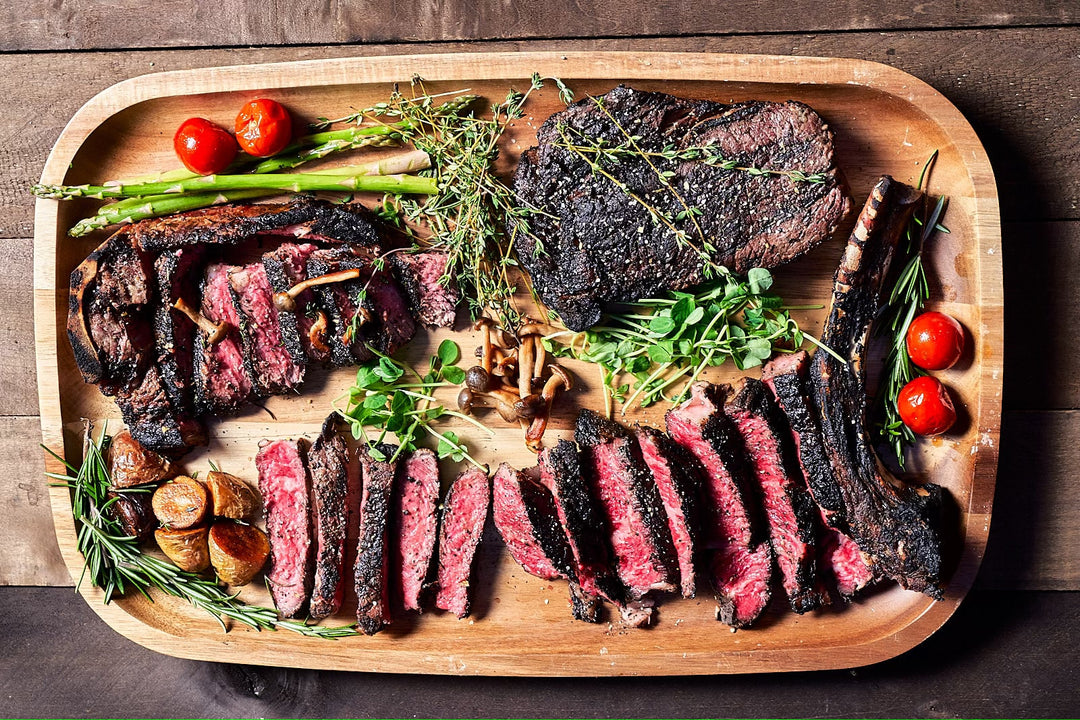CHOOSING YOUR STEAK BASED ON SHAPE, MARBLING, TEXTURE, AND THICKNESS
Edited on 08/23/2023
Selecting the ideal steak for your palate can be an art in itself. You might say that you don't need help choosing the steak you like, and that's perfectly fine. But there are certain tricks of the trade to help you pick out the best one.
For example, a ribeye that has a lot of marbling and high fat content throughout the steak. It has more flavour due to that extra fat. The difference between prime and choice is less pronounced in a ribeye because of that natural extra fat.
Texture
The steak texture determines how it feels in your mouth and how it responds to your palate. A ribeye is softer than a New York strip. A filet mignon is softer than a ribeye.
The New York Strip is more firm than the filet and ribeye. It has a stronger feel to it and doesn't cut as easy, but it has a deep, rich flavor.
A Ribeye has everything. The soft cap, a lot of fat, and the eye of the ribeye which is more similar to the New York.
A Filet Mignon has a very soft texture, almost like a pillow. It has a buttery feel to it and is very easy to cut. People refer to it as the steak of kings.

Fat Content
The distribution of fat within a steak influences not only its flavor but also its overall mouthfeel.
The Filet Mignon, known for its tenderness, has very little fat content, with subtle striations providing a hint of richness.
The New York Strip tends to have its fat concentrated along the edges and tail, contributing to its distinct flavor profile.
The Ribeye stands out with fat marbled throughout the cut, resulting in a steak that's both juicy and flavorful. The USDA Prime grading of the Mr. Steak's Ribeye adds even more flavor with it's immense marbling.
If you really want that savory, meaty, fatty steak with all the flavor in the world - go for the Ribeye. If you're looking a tremendously flavored steak that's a little more lean - go for the Filet Mignon. If you're somewhere in the middle - go for the New York Strip.
Marbling (aka Fat Striations)
Marbling is the fat striations running through the steak. Feeding a cow grain or corn achieves higher marbling levels. Steak marbling plays a significant role in enhancing the flavor and tenderness, marbled steaks are more juicy and savory.
USDA Prime has the highest marbling of any USDA grading - followed by Choice, and then Select. Marbling refers to the striations running throughout the meat of the steak. Fat content refers to all the surrounding fat and fat associated with the cut.

Thickness
Thickness is a crucial factor in determining how your steak cooks and ultimately tastes. Thin steaks cook fast and won't have the ability to have as much flavor as thick steaks. Thin steaks are good when the cut is naturally skinny or marinated to give it flavor.
To achieve a really flavorful, full-bodied steak, it needs thickness to it. When grilling thick steaks, you infuse more flavors, it doesn't burn, and overall will be better.
"A thin steak is like thin tires on a car. They'll get you there, but it'll be a rougher ride and you won't enjoy it quite as much." - Mick Scully, Mr. Steak
Mr. Steak Recommended Thickness For Each Cut:
Filet Mignon - Minimum 1-1/4 inches
Ribeye - Minimum 1 inch
New York Strip - Minimum 1-1/4 to 1-1/2 inches
Size
8 - 10 oz Filet Mignon is quite big. That's 8 - 10 oz of pure meat. If you had the same size in a ribeye, you may only have 4 or 5 oz of actual meat. So you need a bigger ribeye to get the same amount of meat that you'd get on a filet.

Steak sizes vary due to the nature of each cut. A Ribeye steak's fat content raises the overall weight of the cut, but not the total amount of meat. The same is true with bone-in cuts, as that adds additional weight to the steak too.
Bone-In Vs Boneless
The choice between bone-in and boneless cuts can impact the flavor and experience of the steak.
New York Strip and Kansas City Strip are pretty much the same cut. The difference is that the New York is boneless and the Kansas City Strip has the bone left in.
Mr. Steak prefers the Kansas City Strip because of that little bit of extra flavor added from the bone. It doesn't make that much difference, but it makes a little.
Mr. Steak puts Bone-In and Boneless side by side to compare and finally end the debate.

Conclusion
By considering all these factors, you're embarking on a journey to steak perfection. Each choice you make contributes to the overall taste, tenderness, and satisfaction you derive from your culinary experience. Knowing the qualities of different cuts of steak can help you make a better choice for yourself. For instance, knowing the marbling of Ribeye, the tenderness of Filet Mignon, or the bite of New York Strip.
With Mr. Steak's help, you can confidently navigate your way from the freezer to the grill to your plate. The choice is yours, and the possibilities are as vast and flavorful as the cuts themselves.

















Leave a comment